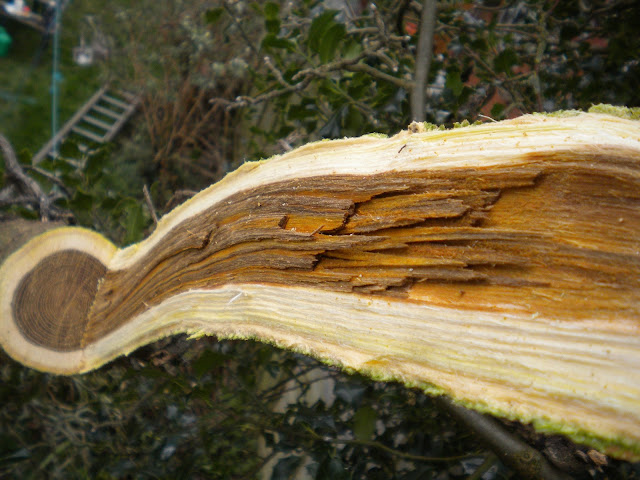A few days ago I went along with bat enthusiasts and experts to a nearby wood to help put up bat boxes in the hope that they would provide roosting places for Barbastelle bats which in south Warwickshire are on the northern most limit of their range in this country.
If you are wondering why they are called Barbastelle bats it is because of the white hairs sticking out from the lower lip and body and if you recall any Latin you will know the barba bit means beard and the stella bit means star so you get Star -Beard. The full scientific name is Barbastella barbastellus so when it was originally named they made sure you knew it has a star beard by stressing it twice. I was no Latin scholar but what I remember of Latin makes me think can you have two different endings i.e. 'a' and 'us' like that?
What do you mean you didn't do Latin at school? Just how young are you? C'mon, Amo, amas, amat, amamus, amatis, amant - all you need is love. Tra la lala laa.
I haven't seen a Barbastelle bat yet, in fact I haven't seen any bat close up but (and this is how to upset the bat men and women) don't they all look the same? Just funny noses and ears? Just kidding, all you chiroptologists.
The bats are being surveyed in South Warwickshire by listening out for the tell tale high pitched squeaks and pips which are only detectable with special gear (each species has a unique sound.) and also by tracking the tiny transmitters attached to the bats.
If you are local to Warwickshire and want to get involved or just want to know more click
here and here.

This design of box has been shown in other locations to be the preferred type for this bat. They like to roost in cosy, tight places such as behind loose bark or in damaged branches. The 'fins' are unequally spaced so they can choose a gap size they prefer.
Having crawled up the gap they will roost in the cavity at the top. The lid is hinged for careful inspection by authorised people to see if there any bats roosting.
Boxes are nailed to trees at least three metres up and with aluminium nails so if the nail is still in the tree when it is felled and planked then minimal damage will be done to the chainsaw or sawmill.
Boxes are fixed facing south so the bats benefits from the extra warmth and positioned so that there is a clear run in with no small branches in the way.
Prunus incisa 'Kojo no mai'
Here is a group of Prunus incisa 'Kojo no mai' in a rather insalubrious car park setting. They are a fabulous and frothy mass of lively white and pink
You know when you see a variety name like 'Kojo no mai' that it is Japanese and is usually an elegant and poetic description of the plant. Similarly many of the Wisteria varieties have evocative Japanese names. I tried to find out what this name meant and various references suggested something to do with butterflies but my Japanese dictionary suggested something completely different and completely nonsensical. I had factory and ruined castle coming up and that sure didn't sound elegant. I decided to enlist the help of a Japanese friend and she sent me this lovely, detailed email below.
'Somebody at work asked me the same question today - what a coincidence!
You were getting close, factory and ruined (ancient) castle - they are both spelled the same in alphabet but pronunciation is slightly different. Also they are given totally different Chinese characters...
I know you wouldn't go that far (Chinese characters) though!
Kojo 工場ーfactory
Kojo 古城ーancient castle
Kojo 湖上 no mai 舞
湖上 kojo ー on the lake / on the water
舞 mai ー traditional Japanese dance
'no' is a particle so I would translate, 'Dancing on the lake' - happy?'
Happy? I couldn't be happier!
Thank you.
Death and decay.
Coup de Grass
I have always been unsure about just what exactly you can get away with when it come to cutting back grasses. If you think it through logically with them being grasses an' all they are likely to get grazed by some creature or another at some time in their life and evolution must surely have given them the ability to survive a munching. So in theory they should survive a haircut at almost any time of the year but none the less I get nervous about cutting them back hard at all. Some of them eventually get so untidy that the bullet must be bitten ( I want to say bited) and the shears brought out.
This is a picture of Stipa tenuissima that had grown scruffy during the winter after two seasons of no treatment so come spring time I cut it down almost to the ground and within a week the results were very encouraging. See below. I shall be tempted next year to cut one or two of them back a few weeks after flowering to see if I can avoid the myriad of seedlings that will inevitably sprout up if I don't cut of the seedheads and then see if I still get a decent looking plant for the second part of the season.
The grass was cut back in mid April and this new growth appeared after just one week.
It is easy to imagine it as a confection - a thin slice of this drizzled over with a blackurrant coulis. Yummee.
How not to cut down a tree. In this case it didn't matter because the whole thing was coming down but it does show what can happen if you don't make the right cuts.
That's it for now.













No comments:
Post a Comment